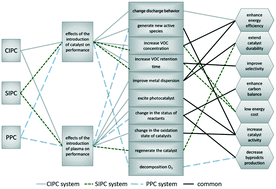当前位置:
X-MOL 学术
›
Catal. Sci. Technol.
›
论文详情
Our official English website, www.x-mol.net, welcomes your
feedback! (Note: you will need to create a separate account there.)
Synergistic effects and mechanism of a non-thermal plasma catalysis system in volatile organic compound removal: a review
Catalysis Science & Technology ( IF 4.4 ) Pub Date : 2017-12-19 00:00:00 , DOI: 10.1039/c7cy01934c Xinxin Feng 1, 2, 3, 4, 5 , Hongxia Liu 1, 2, 3, 4, 5 , Chi He 1, 2, 3, 4, 5 , Zhenxing Shen 1, 2, 3, 4, 5 , Taobo Wang 1, 2, 3, 4, 5
Catalysis Science & Technology ( IF 4.4 ) Pub Date : 2017-12-19 00:00:00 , DOI: 10.1039/c7cy01934c Xinxin Feng 1, 2, 3, 4, 5 , Hongxia Liu 1, 2, 3, 4, 5 , Chi He 1, 2, 3, 4, 5 , Zhenxing Shen 1, 2, 3, 4, 5 , Taobo Wang 1, 2, 3, 4, 5
Affiliation

|
Non-thermal plasma catalysis with high efficiency, high by-product selectivity and superior carbon balance is one of the most promising technologies in the control of volatile organic compounds (VOCs). Non-thermal plasma catalysis can be subdivided into three types: continuous operation in plasma catalyst (CIPC) system, sequential operation in plasma catalyst (SIPC) system and post plasma catalyst (PPC) system. In this review, a comprehensive discussion on the synergistic mechanism of the CIPC, SIPC and PPC systems is provided. For CIPC, the introduction of catalysts changed the discharge behavior and generated new active species. Plasma discharge modified catalyst surfaces were summarized. The behavior and mechanism of catalyst adsorption and surface reactions within a plasma reactor and plasma oxidation in SIPC were discussed. For PPC, the performance of the plasma modified gas composition and temporarily activated catalysts were analyzed. In addition, the by-product inhibition by catalysts was also discussed. Moreover, the synergistic effects of the plasma and catalysts of the three systems on VOC destruction were critically reviewed. Based on these studies, the catalyst characteristics suitable for the CIPC, SIPC and PPC systems were summarized. Finally, the outlook on non-thermal plasma catalysis coupled systems in VOC control was proposed. It can be reasonably anticipated that this review is meaningful for deepening our understanding of the fundamental scientific principles regarding the catalytic oxidation of VOCs in non-thermal plasma catalysis systems, providing valuable and feasible references for researchers and designers on the efficient reduction and control of VOCs.
中文翻译:

非热等离子体催化系统去除挥发性有机化合物的协同效应及其机理研究进展
高效率,高副产物选择性和出色的碳平衡的非热等离子体催化是控制挥发性有机化合物(VOC)的最有前途的技术之一。非热等离子体催化可分为三种类型:等离子体催化剂(CIPC)系统中的连续操作,等离子体催化剂(SIPC)系统中的顺序操作和后等离子体催化剂(PPC)系统。在这篇综述中,对CIPC,SIPC和PPC系统的协同机制进行了全面的讨论。对于CIPC,催化剂的引入改变了放电行为并产生了新的活性物质。总结了等离子体放电改性的催化剂表面。讨论了SIPC中等离子体反应器内催化剂吸附和表面反应以及等离子体氧化的行为和机理。对于PPC,分析了等离子体改性气体组合物和临时活化催化剂的性能。另外,还讨论了催化剂对副产物的抑制作用。此外,严格审查了等离子体和这三个系统的催化剂对VOC破坏的协同作用。基于这些研究,总结了适用于CIPC,SIPC和PPC系统的催化剂特性。最后,提出了VOC控制中非热等离子体催化耦合系统的展望。可以合理预期,该综述对于加深我们对非热等离子体催化系统中VOC催化氧化基本科学原理的理解,为研究人员和设计人员有效减少和控制VOC提供有价值和可行的参考。 。
更新日期:2017-12-19
中文翻译:

非热等离子体催化系统去除挥发性有机化合物的协同效应及其机理研究进展
高效率,高副产物选择性和出色的碳平衡的非热等离子体催化是控制挥发性有机化合物(VOC)的最有前途的技术之一。非热等离子体催化可分为三种类型:等离子体催化剂(CIPC)系统中的连续操作,等离子体催化剂(SIPC)系统中的顺序操作和后等离子体催化剂(PPC)系统。在这篇综述中,对CIPC,SIPC和PPC系统的协同机制进行了全面的讨论。对于CIPC,催化剂的引入改变了放电行为并产生了新的活性物质。总结了等离子体放电改性的催化剂表面。讨论了SIPC中等离子体反应器内催化剂吸附和表面反应以及等离子体氧化的行为和机理。对于PPC,分析了等离子体改性气体组合物和临时活化催化剂的性能。另外,还讨论了催化剂对副产物的抑制作用。此外,严格审查了等离子体和这三个系统的催化剂对VOC破坏的协同作用。基于这些研究,总结了适用于CIPC,SIPC和PPC系统的催化剂特性。最后,提出了VOC控制中非热等离子体催化耦合系统的展望。可以合理预期,该综述对于加深我们对非热等离子体催化系统中VOC催化氧化基本科学原理的理解,为研究人员和设计人员有效减少和控制VOC提供有价值和可行的参考。 。











































 京公网安备 11010802027423号
京公网安备 11010802027423号